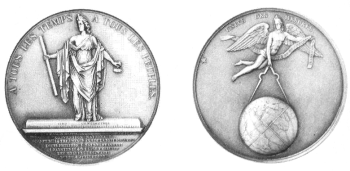
| Measure, Metre, Irony: Reuniting Pure Mathematics with Architecture |
|---|
Professor of Architecture
Director of Studies for Architecture
Department of Architecture & Civil Engineering
University of Bath
Bath BA2 7AY UK
A nation's measuring rod is the most succinct and precise statement of the dominating forces within a civilised society. Consequently, measure is representative of culture and is an essential aspect of the history of ideas. Yet, neither scientists nor historians have considered measure as an art. More usually it is presented one-sidedly, as a catalogue of related numbers and quantities, which have quasi-scientific status.

Commemorative medal of the metric system, designed in 1799 but not cast until 1840. Pavillon de Breteuil, Sèvres, Paris
The idea and reality of what measure represents has been transformed. Measures in western society were once mostly derived from the notion of the ideal male body, its qualities and proportions as well as its dimensions. These were represented in classical sculptures and buildings, artefact that have influenced art and architecture into modern times. However, during the European Enlightenment the body as measuring standard was criticised. Scientists and politicians became intent on providing a system of rational, universal measures independent of the human body, and the metre rod was formulated.
It is the idea of measure - what it purports to be and what it actually represents - that is the focus of this paper. Measure, I will argue needs to be recognised as more than an abstract calibrated length of inert material: it is a deliberate consequence of human thought - in Latin, mens (the root of 'measure') - and the dissembler - in Greek, eiron (the root of 'irony') - and simulator of power. The metric system has universal authority - except in the USA - but it is no more rational than the idealised body that once dominated the ancient world. Indeed, I will argue that it might be better understood as the measure of all irony.
ABOUT THE AUTHOR
Robert Tavernor is a registered architect and Professor and Head
of Architecture at the University of Bath, UK. He studied architecture
in London, the British School at Rome and Cambridge University,
where he graduated with a PhD in 1985. He was appointed Forbes
Professor of Architecture at the University of Edinburgh 1992-95,
and has been Professor of Architecture at Bath since 1995. In
1998 he was also Visiting Professor to the Center for Medieval
and Renaissance Studies, UCLA. He is the author of Palladio and
Palladianism (Thames & Hudson 1991: English, Italian, Chinese
and Korean eds.), and On Alberti and the Art of Building (Yale
UP 1998); co-translator and editor of Leon Battista Alberti:
On the Art of Building, in Ten Books (MIT Press 1988), and Andrea
Palladio: The Four Books on Architecture (MIT Press 1997); editor
of Edinburgh (Rassegna 64, 1995: English and Italian eds.) and
co-editor of Body and Building: On the Changing relation of Body
and Architecture (MIT Press 2002).
|
Robert Tavernor, "Measure, Metre, Irony: Reuniting Pure Mathematics with Architecture", pp. 47-61 in Nexus IV: Architecture and Mathematics, eds. Kim Williams and Jose Francisco Rodrigues, Fucecchio (Florence): Kim Williams Books, 2002. http://www.nexusjournal.com/conferences/N2002-Tavernor.html |
|
|
|
|
